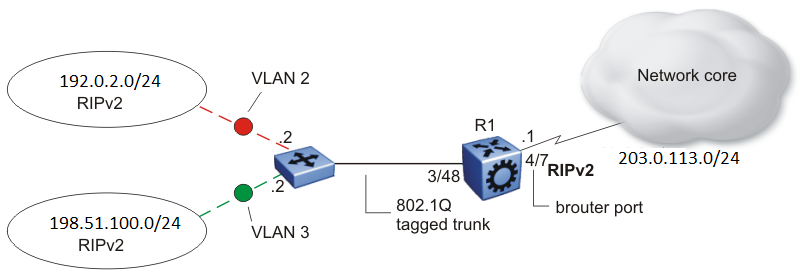Configuring RIP on an interface
Configure RIP on Ethernet ports and VLANs so that they can participate in RIP routing.
Before you begin
Assign an IP address to the port or VLAN.
Configure RIP and enable it globally.
Configure in and out policies.
About this task
RIP does not operate on a port or VLAN until you enable it both globally and on the port or VLAN.
To configure RIP on a VRF instance for a port or VLAN, you configure RIP on the port or VLAN, and then associate the port or VLAN with the VRF.
Procedure
Example
The following configuration example shows how to configure the switch (labeled R1) to operate only in RIP version 2 mode.

Enable RIPv2 send mode on VLAN 2:
Switch:1(config-if)# ip rip send version rip2
Enable RIPv2 receive mode on VLAN 2:
Switch:1(config-if)# ip rip receive version rip2
Repeat these commands on VLAN 3 and the port interfaces.
Variable definitions
The following table defines parameters for the ip rip command.
|
Variable |
Value |
|---|---|
|
advertise-when-down enable |
Enables or disables AdvertiseWhenDown. If enabled, RIP advertises the network on this interface as up, even if the port is down. The default is disabled. If you configure a port with no link and enable advertise-when-down, it does not advertise the route until the port is active. RIP advertises the route even when the link is down. To disable advertising based on link status, you must disable this parameter. |
|
auto-aggregation enable |
Enables or disables automatic route aggregation on the port. If enabled, the switch automatically aggregates routes to their natural mask when an interface in a different class network advertises them. The default is disable. |
|
cost <1-15> |
Configures the RIP cost for this port (link). |
|
default-listen enable |
Enables DefaultListen. The switch accepts the default route learned through RIP on this interface. The default is disabled. |
|
default-supply enable |
Enables DefaultSupply. If enabled, this interface must advertise a default route. The default is false. RIP advertises the default route only if it exists in the routing table. |
|
enable |
Enables RIP routing on the port. |
|
holddown <0-360> |
Configures the RIP holddown timer value, the length of time (in seconds) that RIP continues to advertise a network after it determines that the network is unreachable. The default is 120. |
|
in-policy WORD<0-64> |
Configures the policy name for inbound filtering on this RIP interface. This policy determines whether to learn a route on this interface and specifies the parameters of the route when RIP adds it to the routing table. |
|
listen enable |
Specifies that the routing switch learns RIP routes through this interface. If enabled, the switch listens for a default route without listening for all routes. The default is enable. |
|
out-policy WORD<0-64> |
Configures the policy name for outbound filtering on this RIP interface. This policy determines whether to advertise a route from the routing table on this interface. This policy also specifies the parameters of the advertisement. WORD<0-64> is a string of length 0–64 characters. |
|
poison enable |
Enables Poison Reverse. If you disable Poison Reverse (no poison enable). Split Horizon is enabled. By default, Split Horizon is enabled. If you enable Split Horizon, the interface does not advertise IP routes learned from an immediate neighbor back to the neighbor. If you enable Poison Reverse, the RIP updates sent to a neighbor from which a route is learned are poisoned with a metric of 16. Therefore, the receiver neighbor ignores this route because the metric 16 indicates infinite hops in the network. These mechanisms prevent routing loops. |
|
port {slot/port[/sub-port] [-slot/port[/sub-port]] [,...]} |
Identifies the slot and port in one of the following formats: a single slot and port (slot/port), a range of slots and ports (slot/port-slot/port), or a series of slots and ports (slot/port,slot/port,slot/port). If the platform supports channelization and the port is channelized, you must also specify the sub-port in the format slot/port/sub-port. |
|
receive version <rip1|rip2|rip1orrip2> |
Indicates which RIP update version to accept on this interface. The default is rip1orrip2. |
|
send version <notsend|rip1|rip1comp|rip2> |
Indicates which RIP update version the router sends from this interface. ripVersion1 implies sending RIP updates that comply with RFC1058. rip1comp implies broadcasting RIP2 updates using RFC1058 route subassumption rules. The default is rip1Compatible. |
|
supply enable |
Specifies that the switch advertises RIP routes through the port. The default is enable. |
|
timeout <15-259200> |
Configures the RIP timeout interval in seconds. The default is 180. |
|
triggered enable |
Enables automatic triggered updates for RIP. |


